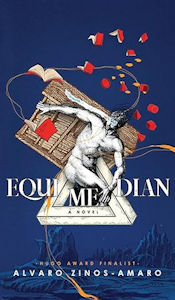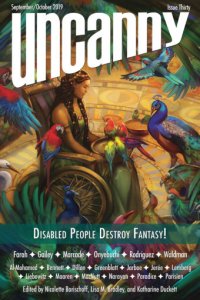Gary K. Wolfe reviews Emmi Itäranta
The City of Woven Streets, Emmi Itäranta (Harper Voyager UK 978-0007536061 8.99, 332pp, tp) June 2016. As Weaver (Harper Voyager 978-0-06-232617-1, $14.99, 310pp, tp) November 2016.
 The Weaver, published earlier this year in England under the far more evocative title The City of Woven Streets, is the second novel from the Finnish writer Emmi Itäranta, whose post-apocalyptic SF novel The Memory of Water deservedly gained attention a couple of years ago, largely because of her evocative, lyrical prose (she apparently writes simultaneously in Finnish and English). That prose serves her well in The Weaver, which has a more clearly fantasy affect, even though many elements can be read as biopunk SF – the island city which is the setting uses globes of luminescent algae for light, medicinal organisms called medusae, tattoos as emblems of both repression and resistance, and technologies such as microscopes and cable-borne ‘‘air gondolas.’’ The economy seems almost medieval, with a governing council accountable to no one and what amounts to craft guilds with names like the House of Webs, the House of Words, and the House of Fire. Eliana, the narrator, is a loyal member of the House of Webs – hence the weaver of the title – but she also harbors a couple of important secrets, such as the fact that she can read and dream, both of which are forbidden. Dreamers, in fact, are rounded up, branded, and either exiled or sent to a dismal prison called the House of the Tainted.
The Weaver, published earlier this year in England under the far more evocative title The City of Woven Streets, is the second novel from the Finnish writer Emmi Itäranta, whose post-apocalyptic SF novel The Memory of Water deservedly gained attention a couple of years ago, largely because of her evocative, lyrical prose (she apparently writes simultaneously in Finnish and English). That prose serves her well in The Weaver, which has a more clearly fantasy affect, even though many elements can be read as biopunk SF – the island city which is the setting uses globes of luminescent algae for light, medicinal organisms called medusae, tattoos as emblems of both repression and resistance, and technologies such as microscopes and cable-borne ‘‘air gondolas.’’ The economy seems almost medieval, with a governing council accountable to no one and what amounts to craft guilds with names like the House of Webs, the House of Words, and the House of Fire. Eliana, the narrator, is a loyal member of the House of Webs – hence the weaver of the title – but she also harbors a couple of important secrets, such as the fact that she can read and dream, both of which are forbidden. Dreamers, in fact, are rounded up, branded, and either exiled or sent to a dismal prison called the House of the Tainted.
The Gothic undertone of this dystopia is made clear when Eliana visits the ‘‘Museum of Pure Sleep’’, presumably established to celebrate the abolition of the ‘‘dream plague,’’ and views a painting of a young woman ‘‘lying on a bed with her eyes closed, a hand fallen toward the floor over the edge of the bed,’’ and a ‘‘dark shadow’’ sitting on her chest. This is a pretty fair description of Fuseli’s famous painting The Nightmare, and indeed ‘‘night-maeres,’’ as they are called here, are portrayed in very similar terms; anyone visited by these goblin-like forms is a candidate for the House of the Tainted. But there are real-life nightmares as well, and one of them is the hook that opens the story: a young woman, whose name we eventually learn is Valeria, washes ashore battered and bloody, her tongue cut out – and Eliana’s name tattooed on the palm of her hand.
Eliana becomes her protector and eventual lover, and her efforts to track down Valeria’s story lead her first to the girl’s aunt, and then into a deepening web that increasingly suggests all is not as it seems, and that the city’s entire culture – and her own House of Webs – may be built on long history of corruption and deception. Along the way, she confronts an inventive, if sometimes familiar, array of antagonists and helpers, from a pair of officiously brutal cops to a wonderful sort of spider-goddess who seems like a cross between Charlotte and Shelob. While the opening chapters reveal this world to us in a manner so elliptical to at times seem meandering, the plot gains considerably in focus and pacing as Eliana finds herself separated from Valeria and, of course, in great danger. The cataclysmic conclusion, while in keeping with the novel’s nods toward Gothic excess, isn’t quite earned by the narrative that precedes it, but much is redeemed by Eliana’s haunting, wistful, and yet tough-minded narrative voice.






